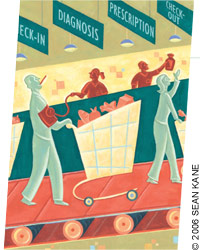 Doctors and hospitals live and work in a parallel universe than the consumers, patients and caregivers they serve, a prominent Chief Medical Information Officer told me last week. In one world, clinicians and health care providers continue to implement the electronic health records systems they’ve adopted over the past several years, respond to financial incentives for Meaningful Use, and re-engineering workflows to manage the business of healthcare under constrained reimbursement (read: lower payments from payors).
Doctors and hospitals live and work in a parallel universe than the consumers, patients and caregivers they serve, a prominent Chief Medical Information Officer told me last week. In one world, clinicians and health care providers continue to implement the electronic health records systems they’ve adopted over the past several years, respond to financial incentives for Meaningful Use, and re-engineering workflows to manage the business of healthcare under constrained reimbursement (read: lower payments from payors).
In the other world, illustrated here by the graphic artist Sean Kane for the American Academy of Family Practice, people — patients, healthy consumers, newly insured folks, kids and caregivers — are seeking convenient, pleasant, frictionless retail-style experiences from the health system. Demands from these people are pushing the health system to transform in ways that serve them the way Uber, Amazon, Nordstrom and Apple do. In a nutshell: as people pay more out of pocket, due to growing penetration of high deductible health plans and bigger out of pocket copayments, people are morphing into health care consumers and expect health care to feel and act like other retail channels they patronize.
My annual health information technology forecast appears in this week’s iHealthBeat, Consumers’ Influence on Health IT in 2015, unpacking this phenomenon. Here, I identify the emerging health care consumer responding to new financial and clinical pressures, and the drivers pressuring the health care industry to meet people where they live, work, play and learn…
- Consumer-directed care gets real as people get shopping
- Word-of-mouth for doctor-shopping goes online
- DIY has come to health care
- Consumer wearables: Getting them to stick
- Crossing the apps chasm from health to medical
- Telehealth will proliferate in 2015
- The importance of social and consumer-generated data
- The dark side of consumer health data
- Consumers and health privacy: Ambiguity
- Consumers still highly trust physicians.
The conclusion: “As consumers bear more financial and clinical decision-making responsibility, their influence will be seen and felt throughout the health care ecosystem. Given peoples’ ubiquitous use of digital technologies in their daily lives, consumers will push providers and payers to be as user-friendly as Amazon, OpenTable and Uber. Those health providers and health insurance plans that provide retail-style convenience will be valued by the growing ranks of health care consumers. And health IT underpins the Uber-ization of health care.”
For more of the detail and data underneath each consumer-health IT phenomenon, you can read the entire piece in the December 16, 2014, edition of iHealthBeat. Thanks to the California HealthCare Foundation for hosting my annual health IT forecast.




 Thanks to Feedspot for naming this blog, Health Populi, as a
Thanks to Feedspot for naming this blog, Health Populi, as a